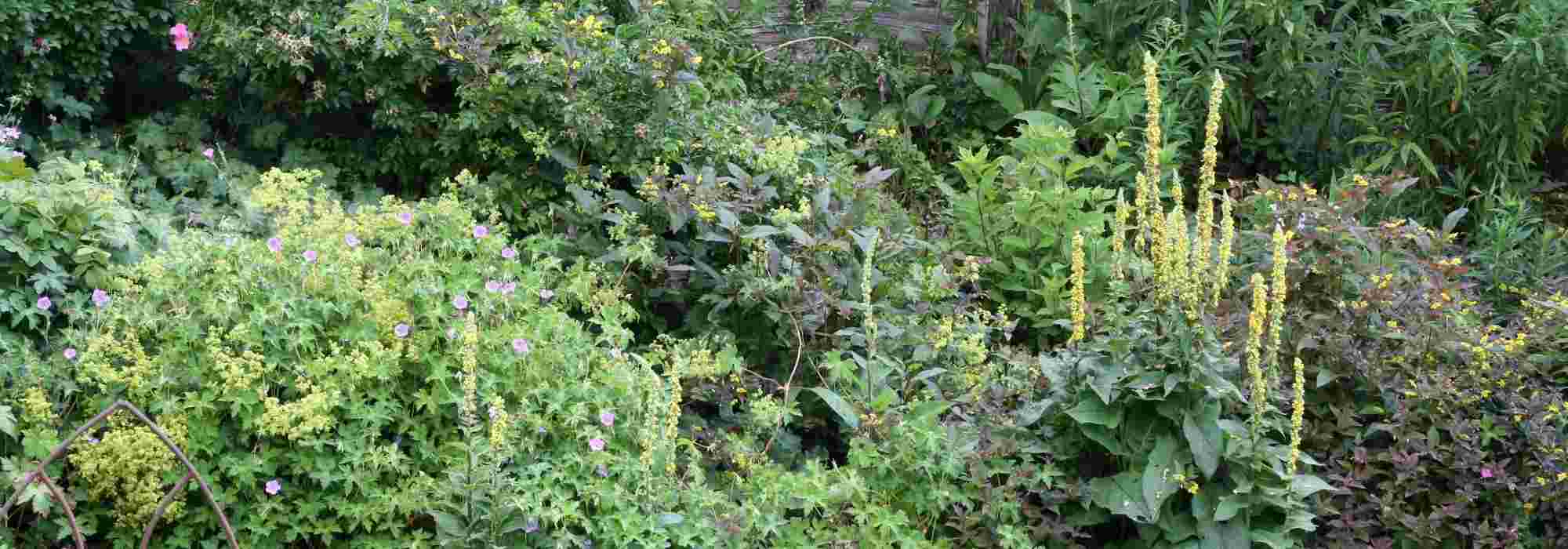
How to landscape a sloping garden?
Tips and tricks to design a sloping garden
Contents
Designing a garden on a slope often poses problems. It can even prove to be a real headache! Yet a sloping site has many advantages. Natural contours of ground are ideal for creating undulations and dynamic, sculpted landscape displays. A slope makes it easier to showcase plants or decorative features; they are all the more visible while respecting rule of ‘short in front and tall at back’.
Whether it has a gentle incline or is very steep, there are always solutions to work with this type of terrain. And with a little creativity and ingenuity, it’s entirely possible to overcome difficulties and turn this ‘drawback’ into a genuine asset.
Let’s explore together solutions for landscaping a sloping garden!
Know your plot, take stock
First, it is essential to know your site and its constraints well.
Indeed, with a sloping site, even more than with a level site, you must take into account its aspect (south-, north- or west-facing slope…), erosion caused by water runoff, lack of water infiltration on the slope; the site is often dry or poor if nutrients are leached. In the worst cases, consider possibility of landslip.
Now that you understand advantages and disadvantages of a sloping site, carry out a site assessment to find out what options are available to you.
Note that :
- if your site has a gentle slope (generally less than 8%), risk of landslip is low and landscaping works are achievable for homeowners. You can tackle them yourself.
- if your site has a steep slope (slope greater than 8%) or unstable materials (gypsum, for example), a professional assessment is essential. A professional will take into account nature of your site and depth of your soil. They will calculate its angle of stability and recommend suitable measures.
Read also
Designing a small gardenChoosing landscaping for your sloping garden
If your site is stable, two landscaping options are available to you:
- Dress your slope without altering it,
- Create successive terraces.
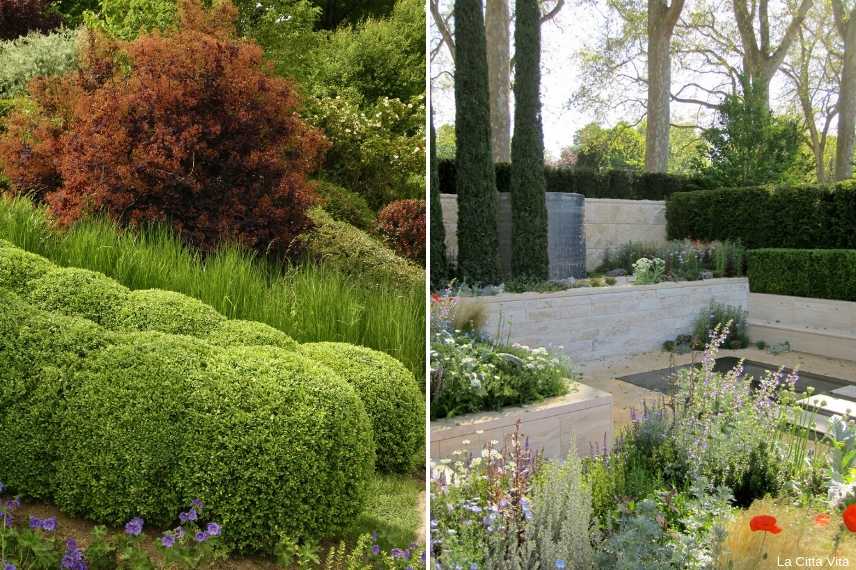
Unmodified slope planted with bushes and grasses / creation of different terraces
Consider advantages and disadvantages of each layout to make your choice. You can also make a “mix” of both approaches and combine a sloping area with a terraced area.
Dressing a slope is possible if gradient is not too steep. This avoids earthworks that are often strenuous and/or costly. However, choice of plant species is limited, soil erosion and water run-off are only attenuated and nutrients can be leached. Finally, access to slope is not made easier, which makes maintenance difficult.
Creating successive terraces makes access to entire slope easier, and soil erosion and water run-off are greatly reduced. However, such work is often more expensive and time-consuming, and is only possible if soil depth allows. Indeed, if there is a rocky bed beneath your plot, you cannot shape terraces.
Also think above all about view and perspective of your slope from living room or terrace. What do you want to see? Successive terraces with different atmospheres, or a slope dressed with a mosaic of plants crossed by a winding path?
When choosing layout, questions of safety and accessibility are essential. If you have children, terracing with successive levels allows installation of guardrails to prevent falls. Stairs with a handrail or gentle, wheelchair-accessible paths can also be preferred solutions for older people or those with reduced mobility.
Landscaping solutions: dressing a slope without altering it
If your slope isn’t too steep and ground is stable, you can create a mosaic planting bed. The slope lets you observe your plants and the layout of your bed even better, so make the most of it!
To dress your slope, use groundcover plants. Thanks to their root systems, these plants stabilise soil, reduce erosion and water runoff. Find our 5 groundcover bush options to landscape a slope. If slope is steep, you can still plant vegetation but first lay a planting membrane, preferably biodegradable. This membrane stabilises soil and plants while allowing water to infiltrate. Find all our advice in our guide: Which mulch for a slope or a sloping bed?
A grassed slope is rarely chosen because it is very demanding. It is difficult to access with a mower and the operation is often hazardous: mower can tip over and is hard to manoeuvre. Maintenance is too frequent and restrictive. Use plants that need very little upkeep and that do not require pruning to flower. There are many low-maintenance groundcovers: ivy, thyme, euphorbias, sedum, periwinkle, fleabane… Create colour patches mixing flowers and evergreen foliage suited to your soil. See our 10 evergreen groundcovers to have and our 5 flowering perennial groundcovers.
Make use of materials already on your land. If you have stones and rock outcrops, showcase them by creating a natural rockery. By working with rock formations and scree you stabilise soil long-term and create a microclimate favourable to rockery plants suited to dry, poor ground. Discover all our perennials for rockeries.
If you opt for a bed with plants that need more water, you can install a drip irrigation system.
Finally, sloping landscaping is ideal for staging a waterfall or small stream. Planting will be enhanced by reflections and the babbling of water.
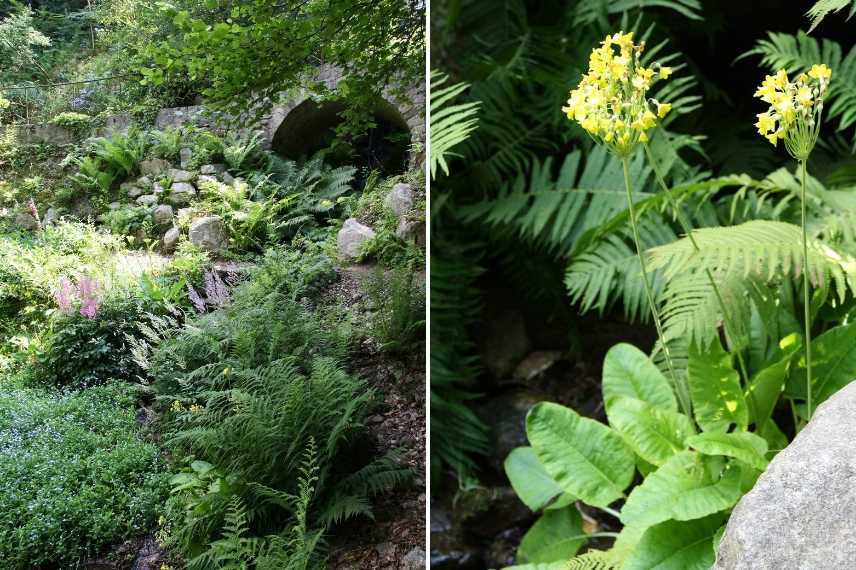
A garden on a slope is ideal for creating a water feature and installing plants that appreciate this damp medium!
Landscaping solutions: creating terraces
Creating terraces involves levelling the slope of your plot into several successive levels, each held by a retaining structure. These successive levels are always built perpendicular to the slope to combat erosion and water runoff. The retaining structure for the terraces can take several forms: a masonry wall, a dry-stone wall, a retaining palisade in wood (using woods resistant to moisture such as black locust, oak, chestnut), gabions or corten steel sheets. Some of these structures can have a dual use: a layer or a support to train climbing plants (vine, kiwi…).
Draw levels regularly or progressively, bearing in mind the soil you have on your plot. Create levels using soil you already have to avoid buying or removing soil. Choose a number of terraces suited to height of your slope. Indeed, if terraces are too large, retaining structures will be more imposing and give a feeling of oppression. If you build terraces yourself, start from top of slope. Terraces are created progressively by taking soil from upper levels to raise lower part into a short stem of bulb. This of course avoids moving soil from bottom to top. For larger jobs, you will need a mini-digger to move significant volumes of soil.
Terrace closest to house is generally reserved for dining and enjoying sun. First terraces are used for areas requiring most maintenance or comings and goings, such as herb garden (closest to kitchen) or vegetable garden. With these terraces, it is even possible to work at height on vegetable garden from terrace. Then lower terraces are reserved for ornamental garden, zen corner or orchard, areas visited less often and requiring less maintenance.
This terracing technique helps create microclimates favourable to certain crops. Soil on terraces warms more quickly in spring and structures such as stone walls help retain heat longer during night and in autumn.
Plant your terraces as you would in a flat garden. Simply adapt to nature of your soil and climatic conditions: Perovskia, Centranthus (valerians), Pennisetum, blue fescues, bottlebrush grasses, lavender… all plants can be suitable.
Pathways and access to your sloping garden
Whatever layout you choose, plan ahead for paths and access in your sloping garden. Several options are possible:
- A gentle zigzag path through your planting beds: grassed, stepping stones … this is possible if slope is not too steep.
- Steps: preferred for steep slopes or terraced layouts.
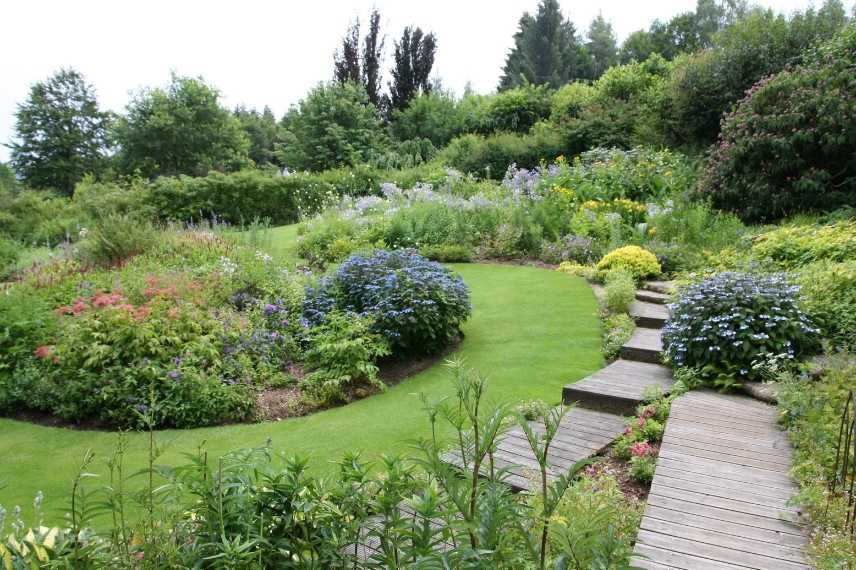
Grassed path and wooden steps providing access to a landing (Berchigranges-2018)
Make steps or a gentle path run dynamically. Vary landings and their length. Let the path wind, allowing it to disappear and reappear visually as you wish.
Each part of your layout should be accessible on foot and suitable for maintenance with your gardening tools. As a rule, keep at least one single-sloped path for mower or wheelbarrow access, for bringing materials or simply for carrying out landscaping work. Remember you will not want to haul a wheelbarrow up steps!
Checklist for landscaping your sloping garden
Before finalising your layout for a sloping garden, check these final essentials :
- safety: nothing should be overlooked.
- water management. Rainwater and water from your irrigation need to be channelled, infiltrated and/or drained to the bottom of your slope.
- garden maintenance. Simplify it as much as possible to keep constraints to a minimum.
- light displays: illuminate your sloping garden at strategic points, results guaranteed.
Now it’s over to you!
- Subscribe!
- Contents
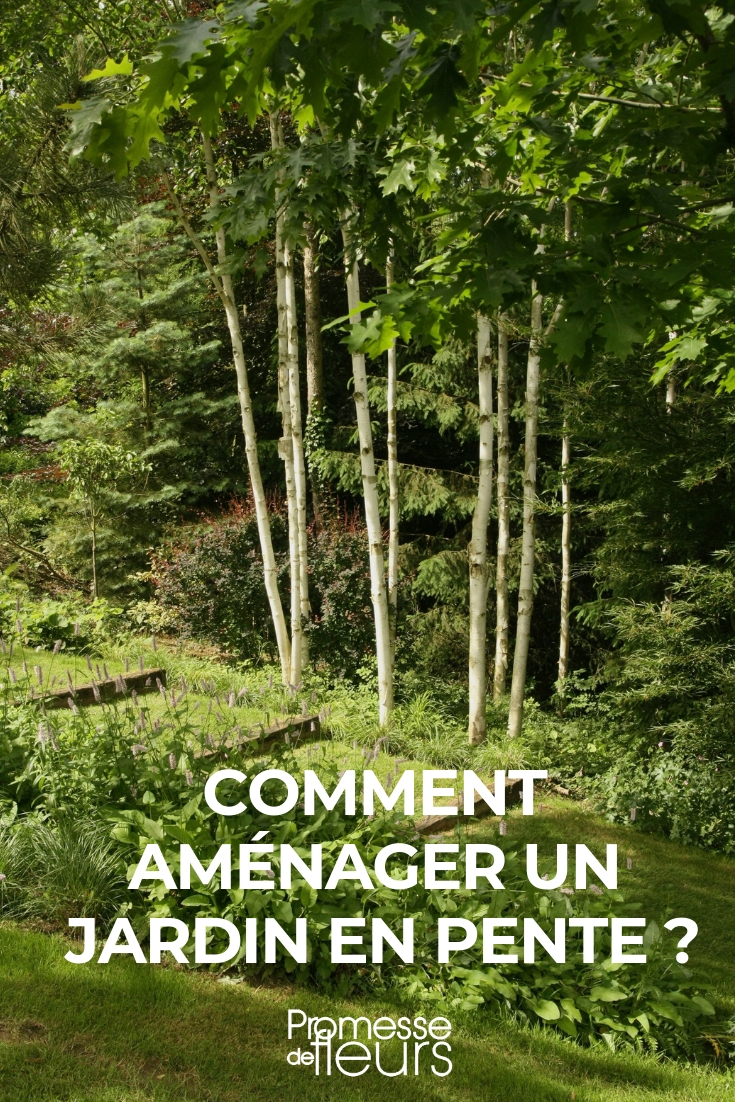































Comments